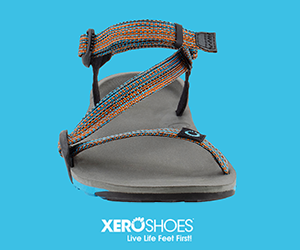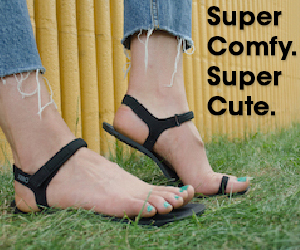Running in barefoot sandals was found to be far more safe and better for promoting foot health as compared with thick cushioned running shoes, and here’s why:

If you’ve read Born to Run, you’ll know who the Tarahumara Indians (shown below) are. If you don’t, the Tarahumara Indians are a tribe in Mexico who are endurance runners, who also run in thin minimalist sandals made of old used car tire rubber. These runners have gained world-wide attention because they run long distances in flimsy sandals, and they don’t injure because they don’t land with a heel strike when they run, they land with a forefoot strike (click here to see what a forefoot strike looks like). This is in stark contrast to many recreational runners who wear running shoes with excessive padding under the heel which causes these runners to heel strike, and get lots of injuries!


One of the many problems with regular running shoes is they have too much cushioning under the heel than the front of the shoe. This giant heel-to-toe offset causes the front of your foot to unintentionally lift up, exposing the heel to the ground, making it easier for the heel to strike the ground first, and in consequence, impact shoots up dramatically.

So, what happens when the Tarahumara Indians go from wearing their minimalist sandals to regular running shoes loaded with cushioning and stability features?
A new study found that regular running shoes negatively altered the natural foot strike, stride length and foot health in Tarahumara Indian endurance runners!

Case in point, a ground-breaking study in the Journal of Sports and Health Science discovered that the Tarahumara Indian endurance runners who habitually wore regular running shoes had different lower leg kinematics than the Tarahumara Indians who habitually wore huarache sandals.
Here are the big conclusive takeaways from the study:
- Tarahumara Indian endurance runners who habitually wore huarache sandals were more likely to land with their ankles below their knee when running. Therefore, they did not over-stride when compared to the Tarahumara Indians who habitually wore regular running shoes.
- Tarahumara Indians who habitually ran in regular running shoes had reduced arch strength
- These shoes contained supportive features that included arch support and were thickly cushioned, especially under the heel.
This data is serious, realistic and credible because it jibes with other work (references below article) showing that thick cushioned running shoes cause rigid heel strike landings, mechanical imbalances such as over-striding, while restricting the proper function of the foot’s arch, leading to weak arches that are unable to act as shock absorbers and motion stabilizers. As mentioned above, the excellent news is minimalist sandals do substantially more to strengthen your feet, while helping you use your forefoot strike safely and efficiently when you run. But, if running in sandals doesn’t interest you, minimalist running shoes are just as effective. In fact, here are all the evidence-backed reasons minimalist shoes work for everyone!

References:
Lieberman, DE. Strike type variation among Tarahumara Indians in minimalist sandals versus conventional running shoes. J Sport Health Sci, 2014; (3)2:86-94.
Nigg, BM and Wakeling, JM. Impact forces and muscle tuning: a new paradigm. Exerc Sports Sci Rev, 2001; 29(1):37-41.
Nigg, BM., Cole, GK., and Burggemann, GP. Impact forces during heel-toe running. J Appli Biomech, 1995; 11(4):407-432.
Bretta Riches
BSc Neurobiology; MSc Biomechanics candidate, ultra minimalist runner & founder of RunForefoot. I was a heel striker, always injured. I was inspired by the great Tirunesh Dibaba to try forefoot running. Now, I'm injury free. This is why I launched Run Forefoot, to advocate the health & performance benefits of forefoot running and to raise awareness on the dangers of heel striking, because the world needs to know.
Latest posts by Bretta Riches (see all)
- Can You Run In Barefoot Shoes? Yes, But DON’T Heel Strike! - 21/07/2024
- Why Cushioned Running Shoes Are Really Bad for Your Feet - 19/07/2024
- Do Cushioned Running Shoes Cause Injuries? - 17/07/2024
